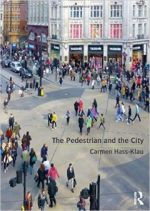The Pedestrian and the City

In The Pedestrian and the City Carmen Hass-Klau brings us a remarkable volume of content. This comes in the form of both breadth, as she draws upon experience from North America and Europe, and depth, as she traces not only the historical development of cities but also their current practices relating to walking issues. Thus this contribution to contemporary pedestrian planning is informative for those involved in the shaping of towns and cities, including students and practitioners of planning, as well as geographers, transport engineers and local government officers.
Hass-Klau’s book has two distinct yet connected parts: Part I, “History” and Part II, “Practice”. Despite their simple titles these parts are packed with historical and empirical information that paint a vivid picture of urban development and related walking issues, and the development of pedestrianization (in both policy and practice). Whilst Part I attends to experiences in the United States, West and East Germany and Britain, Part II brings us detailed insight from 26 cities across Britain, Germany, Denmark, Norway, the USA and Canada, and includes a wealth of transport data, maps and photographs.
Part I comprises of seven chapters. Chapter 1 begins in the United States and traces the historical evolution of urban form in relation to street layout, housing, and the creation of greenbelt (satellite) towns and garden apartments. It also notes the impact of increasing motor vehicle ownership and use upon urban environments, and how although some cities fought to maintain a pedestrian-friendly environment many welcomed the convenience the car provided (page 17).
Chapters 2, 3 and 4 move to West Germany. In Chapter 2 Hass-Klau charts how during the Third Reich Adolf Hitler propelled forward both motorization and the building of new communities. In addition to discussing their impact upon urban form, she identifies how pedestrianization, no through traffic, more road construction and street widening, as well as a new vision for the city centre, became key issues facing city centres during the 1930s–40s (pages 27–29). Chapter 3 focuses on the post-war period between 1945 and the end of the 1960s. In particular it looks at how the rapid growth in car ownership and ideas from the Athens Charter impacted upon transportation and planning in post-war West Germany. To conclude the discussion on West Germany, Chapter 4 looks at how research and practice on pedestrianization, public transport and traffic calming grew during the 1970s and 1980s under the Social Democrats as they promoted liveable cities and city centres.
Chapter 5 turns to East Germany. Hass-Klau considers what happened to cities under the communist rule of the German Democratic Republic and notably how pedestrianization was promoted as a popular transportation policy (page 76). Part I ends with Chapters 6 and 7, which provide a detailed look at Britain’s approach toward improving road safety from the 1940s to the early 1970s (Chapter 6), and the implementation of “traffic calming” measures between the late 1970s and 1990s (Chapter 7).
Part II comprises of eight chapters. Chapters 8 to 14 look at the issue of walking throughout 26 cities in Europe and North America. The author draws upon information from local officials, and has personally visited and “walked” each city to honestly evaluate their successes and limitations in implementing walking infrastructure and initiatives.
To conclude, Chapter 15 reviews Parts I and II. Although Hass-Klau identifies a decline in walking, her conclusion summarizes how to promote walking in urban areas, what the challenges are to walking, and realistically what we can hope to achieve namely by changing “flexible features” of the urban environment.
Book note prepared by Hannah Keren Lee
Search the Book notes database
Our Book notes database contains details and summaries of all the publications included in Book notes since 1993 - with details on how to obtain/download.
Use the search form above, or visit the Book notes landing page for more options and latest content.
For a searchable database for papers in Environment and Urbanization, go to http://eau.sagepub.com/

